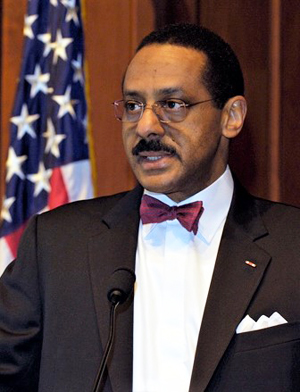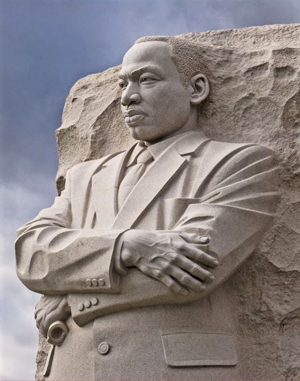
By Robert Smith, African American Legacy Project
Special to The Truth
“Public Art speaks to the Identity of a nation, especially if it is Public Art on the National Mall itself.” — Dr. Ed Jackson, Jr
Fifty-five years ago, [1968] Dr. Martin Luther King was assassinated. Twenty-seven years ago [1996] five African American men initiated an act which led to the pursuit of a national monument honoring the fallen civil rights leader and international humanitarian. Twelve years ago [2011] the living memorial dedicated to Dr. King was unveiled on the National Mall in our nation’s capital.
Ed Jackson, Jr., PhD, served as the Executive Architect for the Washington, DC, Martin Luther King, Jr., National Memorial Project Foundation, Inc. from November 1996 to March 2012.
In 1996, the United States Congress authorized the Secretary of the Interior to permit Alpha Phi Alpha fraternity to establish a memorial on Department of Interior lands in the District of Columbia, giving the fraternity until 2003 to raise $100 million and break ground. In 1998, Congress authorized the fraternity to establish a nonprofit foundation – the Washington, D.C. Martin Luther King Jr. National Memorial Project Foundation, Inc.– to manage the memorial’s fundraising and design, and approved the building of the memorial on the National Mall. In 1999, the United States Commission of Fine Arts (CFA) and the National Capital Planning Commission (NCPC) approved the site location for the memorial.
Sitting and listening to Jackson. describe his leadership responsibilities as directing and managing the programming, planning, site selection, design, and construction of the memorial, you just might say Jackson led with grace, fluidity and a sense of purpose moreover… a sense of duty.
Jackson managed an elite group of thinkers and artisans, while at times having to navigate dark political climates. Nevertheless, he had one promise to fulfill. That promise was to Mrs. Coretta Scott King when he whispered, “… I won’t let you down.”
Listen long enough and you might just get the impression that Jackson’s journey was really an experience ordained and choreographed by a higher being. His reply to those who want to confer high praise upon him is, “…it is not about me.”

Jackson wrote about his experiences in a book entitled: The King Memorial: Thousands of Ideas Bound by a Single Vision. You would have naturally thought Jackson’s recent visit to northwest Ohio was to promote his book? Nothing could be further from the truth.
Recently, this architect of enormous experience and clear accomplishment drove nearly a thousand miles to share his professional experiences and life lessons with a group of burgeoning architectural students at Bowling Green State University.
Jackson was invited to present at BGSU by a student. Darius Calhoun, the president of BGSU’S chapter of the National Organization of Minority Architects [NOMAS], sought out accomplished African American architects to speak to BG’s fledging NOMAS group organized by Adjunct Professor Andre Ballard – himself [Ballard] a minority architect who graduated from Hampton University, an HBCU.
Darius reached out to Jackson and others with a heart full of hope, but… no budget. Quietly and effortlessly Jackson found himself on BG’s campus with the unwavering intent of helping this group of architectural neophytes prepare for what lies ahead. Wholeheartedly embracing NOMAS, Jackson dared these young men and women to dream.
Ballard collaborated with Yong Huang an assistant professor of architecture at BGSU; thus, the two men were able to give a second group – sixth year Master of Architecture students – an opportunity to engage with this architect of international consequence whose name will forever be linked to Dr. King.
Jackson was just nine months old when his dad was killed in a car accident while his parents were visiting family in McComb MS. Jackson’s mom made McComb their home and she pursued a college education and went on to become an elementary school teacher.
Jackson says his family worked hard to shield him from the old southern “Jim Crow” way of life. Jackson says, “For whatever reason, our parents wanted us to grow up void of the notion that you had constraints on you, and… that level of freedom of thought – of being – allows you to move beyond present circumstances.” Thankfully, that sense of self-awareness, as well as, his educational accomplishment, combined with his understanding of the historical context which penetrated the moment, found Jackson fully prepared to lead.
He said, during those early years of development, his team struggled trying to decide what the memorial should represent. He says, “Early on, my team agreed the monument had to be a living memorial.” He continues, “Moreover, it was our design program committee’s hope that the memorial could somehow speak to future generations metaphorically and literally about the importance of freedom, peace, justice, democracy and hope.”
One of the first things Jackson did, after agreeing to take on the project, was to drive to Washington D. C. to a bookstore. He wanted to view images of the existing monuments on the National Mall. After all, this new work was going to be directly compared to the existing historical presence. Jackson wanted to know what he and his team could add to the existing tapestry of monuments on the national mall that would be worthy of inclusion. He said, “As far as I was concerned, we had to reach a bar of excellence, second to none…”
Next Week: The King Memorial Pt II: The Task
“We realized the site that had been selected is where the cherry blossoms come in bloom every year – late March, Early April – and they are actually in bloom during the same period that Dr. King was Assassinated”, Dr. Ed Jackson, Jr.
